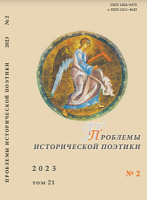Тюркская "кукушка" в олонхо: трансформации и рудименты
The Turkic “Cuckoo” in Olonkho: Transformations and Rudiments
Author(s): Sakhaya D. L’vovaSubject(s): Theory of Literature, Sociology of Literature
Published by: Петрозаводский государственный университет
Keywords: Yakut Olonkho; Altai epic; Tuvan epic; Khakas epic; Shorian epic; image of the cuckoo; golden cuckoo the size of a horse head; folk comparison; totemism; shamanism; Udagan culture;
Summary/Abstract: The article is devoted to the image of cuckoo in the Yakut Olonkho in comparison with the materials of the Altai, Khakas, Shorian and Tuvan epics. In total, 58 Yakut epic texts, including early records of the Olonkho of the 19th - early 20th centuries were analyzed. It is established that while in Turkic folklore the semantics of the image of the cuckoo was ambivalent on the whole, the epic mostly reflects a favourable or neutral attitude to this bird. In positive connotations, the “cuckoo” is more represented as a harbinger of well-being and prosperity. It was also revealed that the comparison “cuckoo the size of a horse᾽s head” previously functioned in all five examined epics; the Altai, Khakas, Shorian and Tuvan epics represented the “golden cuckoo” and the Yakut Olonkho — the “sonorously talking cuckoo”. Hence, the Yakut epic Olonkho could separate from the general, pro-Turkic epic before the development of the “gold cult,” and the earliest variant of the image of the Turkic cuckoo was preserved in it. Five main stable formulas containing the image of the cuckoo have been found in the Yakut epic tradition. All of them have positive connotations: the cuckoo appears as a symbol of eternal summer and prosperity; as a symbol of fertility; as a soothsayer preventing misfortune. The structural variants under the general concept of “the cuckoo-udaganka” represent this bird as a translator between the world of people and the supreme protective deity of the Yakuts, Yuryung Aar Toyon, thus the image of the cuckoo is closely associated with the image of a white sounorous-voiced udaganka. Also distinguished is a group of semantically heterogeneous constructions of the later period (post-1932), most of them with negative connotations, influenced by shamanism, folk omens and beliefs. Thus, the key role in the formation of the Yakut version of the cuckoo image was played by the Udagan culture, and at a later stage certain transformations were introduced by shamanism.
Journal: Проблемы исторической поэтики
- Issue Year: 21/2023
- Issue No: 2
- Page Range: 86-117
- Page Count: 32
- Language: Russian

